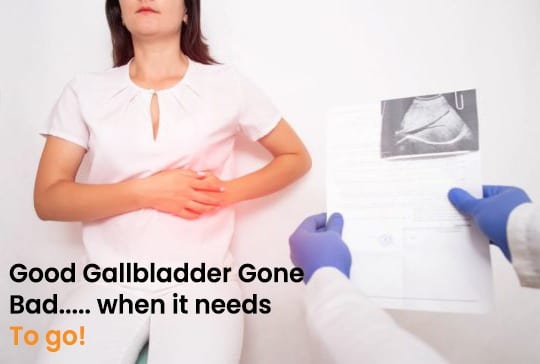
A good gallbladder gone bad. 8 Reasons to consider gallbladder surgery.
When gallbladders act up, some can be salvaged, but others cannot. While some people in my practice follow the “gallbladder diet,” for others, even a strict low-fat diet does not seem to quell symptoms. Unlike kidney stones, gallstones cannot be selectively “broken-up” with sound waves or lasers. They also cannot be “dissolved” with medications (although several are unsafely marketed for this purpose).
Here are 8 scenarios for when the gallbladder has got to go:
- Gallstones – These cholesterol/bile stones can cause infections and inflammation resulting in a surgical emergency. Sometimes symptoms can be as mild as chronic fatigue.
- Pancreatitis – Concentrated bile, biliary crystals (also called microlithaisis) can cause pancreatitis. If you have experienced pancreatitis in the past for unknown reasons, surgical consultation is highly recommended.
- Chronic cholecystitis – Even without stones (acalculus), the gallbladder can become inflamed and cause pain.
- Biliary Polyps – Small growths on the gallbladder require careful surveillance by a trained professional. Polyps which grow in size can harbor cancer and should be appropriately managed.
- Low Ejection Fraction, Biliary Hypokinesia – The HIDA nuclear medicine scan with CCK injection may demonstrate a “lazy” gallbladder which functions at a lower rate.
- High Ejection Fraction, Spastic Gallbladder – Sometimes a spastic gallbladder will function at a higher than normal rate on the HIDA scan with CCK.
- Painful Ejection Fraction, Biliary Dyskinesia – With CCK administration, if pain is experienced during the nuclear medicine exam, promptly report this finding to your technologist and physician. Even with normal “EF” Ejection Fraction, the painful contractions may be dysfunctional in nature.
- Sphincter of Oddi Dysfunction (SOD) – At the end of the common bile duct, a control valve called the Sphincter of Oddi can develop a faulty mechanism. In this case, the gallbladder is the bystander organ that develops problems.
Always be true, and surround yourself with people who affirm your wellbeing. Find a doctor who will slow down and listen; find one who carefully considers your concerns; find one who cares.
